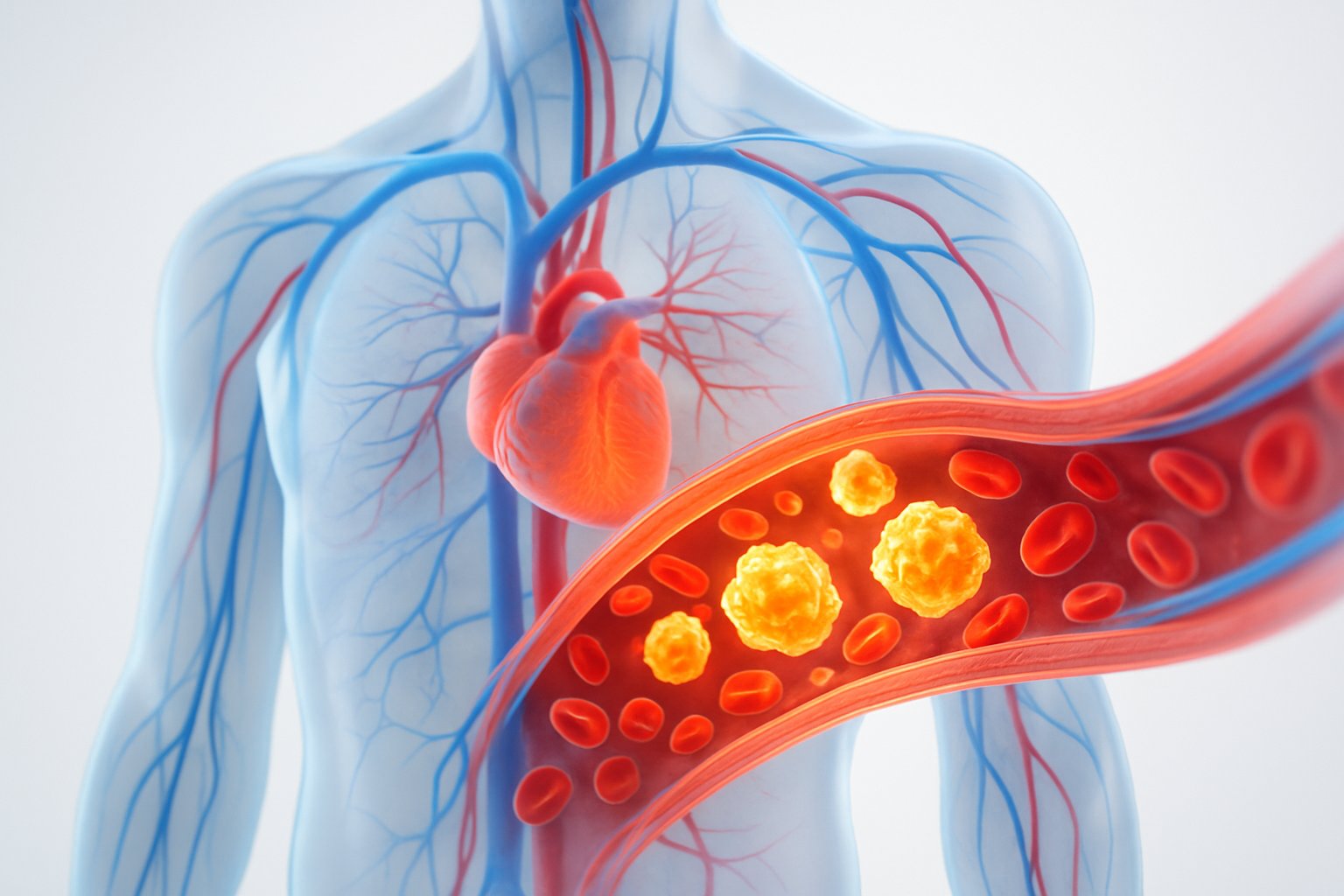When albumin levels in the blood become elevated, a condition called hyperalbuminemia occurs, which can signal several underlying health issues. High albumin in the blood most commonly causes dehydration symptoms like extreme thirst and dry mouth, but can also indicate chronic inflammation, kidney problems, or liver dysfunction that requires medical attention.
Dehydration remains the leading cause of elevated albumin levels[1] because fluid loss concentrates the protein in the bloodstream. When the body loses water through excessive sweating, vomiting, or diarrhea, albumin becomes more concentrated in the remaining blood volume.
An albumin blood test[2] can reveal levels above the normal range of 3.5 to 5.5 grams per deciliter, indicating the need for further investigation. Understanding what triggers high albumin and how it affects the body helps people recognize when medical evaluation becomes necessary.
Key Takeaways
- High albumin levels usually result from dehydration but can indicate serious conditions like chronic inflammation or organ dysfunction
- Symptoms often mirror the underlying cause, such as thirst and dry mouth from fluid loss or fatigue from inflammatory diseases
- Medical evaluation through blood tests and proper hydration management can effectively address most cases of elevated albumin
What Is Albumin and Its Role in the Body?

Albumin is the most abundant protein in blood plasma, making up about half of all proteins in the bloodstream. This vital protein maintains fluid balance, transports essential substances, and keeps blood properly distributed throughout the body.
Functions of Albumin
Albumin serves as the body’s primary transport protein. It carries hormones, vitamins, fatty acids, and medications through the bloodstream to different organs and tissues.
The protein binds to many substances that would otherwise be difficult to transport in water-based blood. These include thyroid hormones, calcium, and various drugs that doctors prescribe.
Albumin also acts as a buffer for pH levels in blood. It helps keep blood neither too acidic nor too basic, which is critical for proper body function.
The protein provides amino acids to tissues when needed. During times of stress or illness, the body can break down albumin to supply essential building blocks for other proteins.
Key transport functions include:
- Hormone delivery to target organs
- Drug distribution throughout the body
- Nutrient transport to cells
- Waste product removal from tissues
Production and Regulation
The liver produces all albumin through a complex process called albumin synthesis. Liver cells called hepatocytes make about 10-15 grams of this protein every day.
Albumin synthesis depends on having enough amino acids available. The liver uses these building blocks from dietary protein and recycled proteins to create new albumin molecules.
Albumin production[3] takes about 20 days from start to finish. The liver makes the protein, releases it into blood, and it circulates for about 20 days before being broken down.
Various factors affect how much albumin the liver makes. Poor nutrition, liver disease, and inflammation can all reduce production significantly.
Albumin in Blood Plasma
Normal albumin levels range from 3.4 to 5.4 grams per deciliter[4] in blood plasma. This represents the largest single protein component in the liquid part of blood.
Serum albumin makes up roughly 60% of total plasma protein. The remaining 40% consists of globulins and other smaller proteins with different functions.
Blood plasma contains about 4-5 grams of albumin per 100 milliliters. This high concentration is necessary for the protein to perform its many critical roles effectively.
When albumin levels change, it often signals problems with the liver, kidneys, or overall nutrition status. Doctors regularly test these levels to check organ function.
Albumin and Osmotic Pressure
Albumin creates most of the osmotic pressure that keeps fluid inside blood vessels. This pressure prevents blood from leaking into surrounding tissues and causing swelling.
The protein’s large size means it cannot easily pass through blood vessel walls. This creates a pulling force that draws water back into blood vessels from tissues.
Osmotic pressure effects:
- Maintains blood volume
- Prevents tissue swelling
- Keeps blood circulation efficient
- Supports proper kidney function
When albumin levels drop too low, osmotic pressure decreases. This allows fluid to leak into tissues, causing edema or swelling in legs, abdomen, or other body parts.
The relationship between albumin and osmotic pressure is so important that doctors often check albumin levels when patients have unexplained swelling or fluid retention problems.
Understanding High Albumin Levels (Hyperalbuminemia)
High serum albumin levels occur when protein concentrations exceed normal ranges in blood tests. The condition involves specific measurements through blood protein analysis and albumin/globulin ratio calculations.
Definition of Hyperalbuminemia
Hyperalbuminemia refers to elevated serum albumin levels above the normal reference range. The most common cause of hyperalbuminemia is dehydration[3], which concentrates albumin in the bloodstream due to fluid loss.
The condition occurs when albumin protein becomes concentrated in blood serum. This happens because the total amount of albumin may remain unchanged, but reduced fluid volume increases the measured concentration.
Primary causes include:
- Severe dehydration from diarrhea or vomiting
- Excessive fluid loss through sweating
- Inadequate fluid intake
- Certain medical conditions affecting protein metabolism
Unlike low albumin levels, high serum albumin levels are less common but still indicate underlying health issues. The elevated readings typically reflect changes in blood volume rather than increased albumin production by the liver.
Healthcare providers use these measurements to assess overall health status. The readings help identify potential problems with hydration, kidney function, or other medical conditions requiring attention.
Normal vs. High Albumin Ranges
Normal albumin levels typically range between 3.5 to 5.5 grams per deciliter (g/dL) in blood tests. Levels above this range are considered high[1] and require further investigation.
High serum albumin levels begin when measurements exceed 5.5 g/dL. Values between 5.6 to 6.0 g/dL indicate mild elevation. Readings above 6.0 g/dL suggest more significant hyperalbuminemia.
Albumin Level Classifications:
- Normal: 3.5-5.5 g/dL
- Mildly High: 5.6-6.0 g/dL
- Significantly High: Above 6.0 g/dL
Laboratory reference ranges may vary slightly between facilities. Age, gender, and individual health factors can influence normal values. Healthcare providers interpret results based on patient history and symptoms.
The degree of elevation helps determine potential causes and treatment approaches. Mild increases often relate to dehydration, while higher levels may indicate more serious underlying conditions.
Serum Albumin and Blood Tests
An albumin blood test checks levels of albumin in blood[2] through a simple blood draw procedure. The albumin test measures protein concentration in blood serum to assess health status.
Healthcare providers often order albumin tests as part of a comprehensive metabolic panel. This broader testing approach provides context for albumin readings alongside other important markers.
Common testing scenarios include:
- Routine health screenings
- Liver function assessment
- Kidney disease monitoring
- Nutritional status evaluation
The blood draw takes place at a laboratory or clinic. A healthcare worker inserts a needle into an arm vein to collect the sample. Results typically become available within 24-48 hours.
Blood protein analysis helps identify various health conditions. The albumin test provides valuable information about liver production, kidney filtration, and overall protein status in the body.
Albumin/Globulin Ratio
The albumin/globulin ratio compares albumin levels to globulin proteins in blood serum. This calculation provides additional insight into protein balance and potential health issues beyond individual albumin measurements.
Normal A/G ratios typically range from 1.0 to 2.5. Healthcare providers calculate this ratio by dividing albumin levels by globulin levels. Higher ratios may indicate elevated albumin or decreased globulin production.
Globulin includes various proteins involved in immune function and other body processes. When albumin increases while globulin remains normal, the ratio becomes elevated. This pattern often occurs with dehydration-related hyperalbuminemia.
Elevated A/G ratios may suggest:
- Dehydration states
- High protein dietary intake
- Certain liver conditions
- Immune system changes
The ratio helps healthcare providers understand the relationship between different blood proteins. This information supports more accurate diagnosis and treatment planning for patients with abnormal albumin levels.
Major Causes of High Albumin in Blood

High albumin levels typically result from dehydration that concentrates proteins in the bloodstream, certain medications that boost protein production, or underlying health conditions that affect the body’s fluid balance. Understanding these main causes helps identify why elevated albumin levels occur[1] and what steps to take next.
Dehydration and Fluid Loss
Dehydration stands as the most common reason for high albumin levels in blood tests. When the body loses fluids, albumin becomes concentrated in the remaining blood volume.
Common causes of fluid loss include:
- Severe vomiting or diarrhea
- Excessive sweating during exercise or heat exposure
- Not drinking enough water throughout the day
- Fever that increases fluid loss through skin
The body maintains the same amount of albumin protein. However, less fluid means higher albumin concentration when measured in grams per deciliter. This explains why dehydration concentrates albumin in the bloodstream[1].
Athletes often show temporarily high albumin after intense workouts. People with stomach flu may also have elevated levels due to vomiting and diarrhea. Proper hydration usually brings albumin levels back to normal ranges within days.
Medications and Supplements
Several medications and supplements can raise albumin levels by affecting protein production or fluid balance. These substances may temporarily increase albumin concentrations in blood.
Key medications that raise albumin include:
- Insulin – affects protein metabolism
- Growth hormone – stimulates protein production
- Anabolic steroids – increase muscle and protein synthesis
- Androgens – male hormones that boost protein levels
People taking these medications for medical conditions may see higher albumin on routine blood tests. Bodybuilders using anabolic steroids often have elevated protein levels, including albumin.
Some protein supplements and high-protein diets can also contribute to increased albumin levels. The liver produces more albumin when protein intake is very high. This effect is usually temporary and not dangerous for healthy people.
Underlying Medical Conditions
Certain health conditions can cause persistently high albumin levels through inflammation or changes in how the body processes proteins. These medical causes require proper diagnosis and treatment.
Conditions linked to high albumin:
- Chronic inflammation from autoimmune diseases
- Severe infections that stress the immune system
- Liver conditions that affect protein production
- Tissue trauma from surgery or injury
Inflammatory conditions like rheumatoid arthritis can stimulate the liver to make more albumin. The body responds to ongoing inflammation by increasing protein production.
Blood draw technique also matters. Using a tourniquet too long during blood collection can artificially raise albumin levels. This happens because local tissue trauma affects protein measurements[1].
Most underlying conditions require treating the root cause rather than just the high albumin levels.
Effects of High Albumin on the Body

High albumin levels can disrupt normal fluid balance and increase blood volume concentration. The kidneys face additional strain while processing concentrated blood, and liver function may be affected depending on the underlying cause.
Impacts on Fluid Balance and Blood Volume
High albumin levels significantly affect the body’s fluid balance system. When albumin concentrations rise, osmotic pressure increases within blood vessels. This creates an imbalance that can pull fluid from surrounding tissues into the bloodstream.
Blood volume becomes more concentrated as albumin levels climb. The protein acts like a sponge, drawing water into the vascular system. This process can lead to increased blood pressure and strain on the cardiovascular system.
The body’s normal fluid distribution gets disrupted. Tissues may become dehydrated while blood vessels contain excess fluid. This imbalance affects how nutrients and waste products move between cells and blood.
Edema patterns change when albumin is high. Unlike low albumin conditions that cause swelling, high levels typically reduce tissue swelling. However, this can mask underlying fluid balance problems that need medical attention.
Kidney Strain and Potential Disorders
The kidneys work harder when processing blood with high albumin concentrations. These organs must filter thicker, more concentrated blood through their delicate filtering units. This increased workload can stress kidney function over time.
Kidney disease may develop or worsen with persistently high albumin levels. The filtering units called glomeruli face increased pressure from concentrated blood. This pressure can damage the tiny blood vessels within the kidneys.
Proteinuria can occur as kidneys struggle with concentrated albumin. The filtering system may start leaking proteins into urine when overwhelmed. This creates a cycle where kidney problems both cause and result from protein imbalances.
Albuminuria specifically refers to albumin appearing in urine. When blood albumin is very high, some may spill into urine as kidneys reach their processing limits. Regular urine testing helps monitor this potential complication.
Liver Health Considerations
Liver function plays a central role in albumin production and regulation. When albumin levels rise, the liver may be overproducing this protein due to inflammation or other stress responses. This overproduction can strain liver resources.
Liver problems like hepatitis or early cirrhosis sometimes trigger increased albumin production. The liver responds to injury by making more proteins, including albumin. This response can temporarily mask liver damage in blood tests.
Fatty liver disease may coexist with high albumin levels. The liver’s fat processing becomes impaired while protein production continues. This creates an imbalance in the liver’s normal functions and metabolic processes.
Chronic liver conditions require careful monitoring when albumin is high. The elevated levels may indicate the liver is working overtime to compensate for other functions that are declining.
Other Physical Symptoms
Fatigue commonly occurs when albumin levels are high. The body uses extra energy to process concentrated blood and maintain fluid balance. This increased metabolic demand leaves people feeling tired and drained.
Weight loss may happen as the body’s fluid distribution changes. Tissues lose water content while blood volume increases. The scale may show lower numbers, but this represents dehydration rather than healthy weight reduction.
Jaundice can develop if high albumin results from liver stress or disease. The yellowing of skin and eyes indicates the liver is struggling with multiple functions simultaneously. This symptom requires immediate medical evaluation.
Digestive symptoms like nausea or loss of appetite often accompany high albumin. The concentrated blood affects how the digestive system processes nutrients and maintains normal function throughout the body.
Risk Factors and Associated Health Conditions

Several health conditions can trigger elevated albumin levels through inflammatory processes that stimulate protein production. Nutritional factors and metabolic disorders also play key roles in disrupting normal albumin balance.
Chronic Inflammation and Immune System Impact
Chronic inflammation stimulates the liver to produce more albumin[1], leading to elevated blood levels. This occurs when the immune system remains active for extended periods.
Autoimmune diseases create persistent inflammation that affects albumin production. Conditions like rheumatoid arthritis, lupus, and inflammatory bowel disease trigger ongoing immune responses.
The immune system releases inflammatory markers during these conditions. These signals tell the liver to increase protein production, including albumin.
Common inflammatory conditions linked to high albumin:
- Rheumatoid arthritis
- Crohn’s disease
- Ulcerative colitis
- Systemic lupus erythematosus
- Chronic infections
Inflammation also affects how the body uses nutrients. This can worsen albumin imbalances over time.
Nutritional and Metabolic Influences
High protein intake can temporarily raise albumin levels in healthy people. The liver responds to increased dietary protein by producing more albumin.
Protein-rich foods that may influence albumin include meat, fish, eggs, and dairy products. Athletes and bodybuilders who consume very high protein diets may see elevated levels.
Nutritional status affects albumin production in complex ways. While malnutrition typically lowers albumin, certain deficiencies can disrupt normal regulation.
Key nutritional factors:
- B vitamins – Essential for protein synthesis
- Vitamin D – Regulates immune function and inflammation
- Antioxidants – Help control inflammatory responses
Metabolic syndrome can influence albumin levels through inflammatory pathways. Insulin resistance and obesity create chronic low-grade inflammation.
Celiac disease affects nutrient absorption, which can impact protein production. The intestinal damage from gluten exposure reduces the body’s ability to absorb nutrients needed for healthy albumin regulation.
Evaluation and Management of High Albumin Levels
Proper evaluation requires specific blood tests to confirm elevated levels and identify underlying causes. Medical attention becomes necessary when symptoms appear or levels remain consistently high, with treatment focusing on addressing root causes rather than the albumin elevation itself.
Diagnostic Blood Tests
The albumin blood test[2] serves as the primary tool for measuring serum albumin levels in the bloodstream. Healthcare providers typically order this test as part of a comprehensive metabolic panel during routine checkups.
Standard Testing Approach:
- Serum albumin measurement (normal range: 3.5-5.5 g/dL)
- Albumin/globulin ratio calculation
- Total protein assessment
The comprehensive metabolic panel[1] provides additional context by measuring related markers. These include liver enzymes, kidney function indicators, and electrolyte levels.
Additional Tests May Include:
- Creatinine levels for kidney function
- Liver function tests (ALT, AST, bilirubin)
- C-reactive protein for inflammation
- Complete blood count
Healthcare providers often repeat testing after 1-2 weeks to confirm consistently elevated levels. Single high readings may result from temporary factors like dehydration or laboratory errors.
When to Seek Medical Attention
Patients should contact their primary care provider when albumin levels exceed 5.5 g/dL on blood test results. Immediate medical attention becomes necessary if symptoms of dehydration or underlying illness develop.
Warning Signs Requiring Prompt Care:
- Severe thirst and dry mouth
- Decreased urination
- Dizziness or weakness
- Persistent fatigue
Individuals with chronic conditions like liver disease or inflammatory disorders need regular monitoring. They should schedule follow-up appointments if albumin levels continue rising despite treatment.
High-Risk Groups:
- People taking medications that affect protein levels
- Athletes or individuals with high protein intake
- Patients with autoimmune conditions
- Those recovering from surgery or trauma
Primary care physicians can evaluate most cases of elevated albumin. Referrals to specialists become necessary when underlying conditions require specialized treatment.
Treatment Options
Treatment focuses on addressing the underlying cause rather than directly lowering albumin levels. Dehydration represents the most common cause[3] and responds well to fluid replacement therapy.
For Dehydration-Related Elevation:
- Increased water intake (8-10 glasses daily)
- Oral rehydration solutions
- Intravenous fluids in severe cases
Dietary Modifications:
- Reduce excessive protein intake if applicable
- Balance protein with adequate carbohydrates and fats
- Increase fluid intake with meals
Chronic inflammatory conditions may require anti-inflammatory medications or disease-specific treatments. Healthcare providers adjust existing medications that might contribute to elevated levels.
Medication Considerations:
- Review insulin, growth hormone, or steroid use
- Adjust dosages when medically appropriate
- Monitor albumin levels during medication changes
Treatment effectiveness gets measured through repeat blood tests every 4-6 weeks initially, then every 3-6 months once levels stabilize.
Prevention and Ongoing Monitoring
Regular monitoring through routine blood work helps detect albumin changes before they become problematic. Most healthcare providers include albumin testing in annual physical examinations.
Prevention Strategies:
- Maintain proper hydration throughout the day
- Follow a balanced diet with moderate protein intake
- Manage underlying health conditions effectively
- Attend regular medical checkups
Monitoring Schedule:
- Annual testing for healthy individuals
- Every 3-6 months for those with chronic conditions
- More frequent testing during illness or medication changes
Patients should track symptoms and report changes to their healthcare provider. Keeping a record of medications, dietary changes, and fluid intake helps identify potential causes of albumin fluctuations.
Early detection through regular monitoring allows for prompt treatment of underlying conditions. This approach prevents complications and maintains optimal protein balance in the bloodstream.
Frequently Asked Questions

High albumin levels can cause specific symptoms related to dehydration and underlying conditions. Most people want to know about the health risks and what steps to take when test results show elevated levels.
What are the possible symptoms associated with elevated albumin levels?
High albumin levels often don’t cause direct symptoms[1] but may show signs of the underlying condition. The most common symptoms relate to dehydration.
People may experience extreme thirst and dry mouth. They might also notice dry skin and reduced urine output.
When chronic inflammation causes high albumin, symptoms can include joint pain and swelling. Fatigue and weakness are also common signs.
Some people develop symptoms from the primary illness causing the elevated levels. These can vary depending on the specific condition involved.
Can high albumin levels be harmful to your health?
High albumin levels themselves are not usually harmful to the body. The main concern is identifying and treating the underlying cause.
Dehydration that causes elevated albumin can be dangerous if left untreated. Severe dehydration can lead to kidney problems and other complications.
Chronic inflammation linked to high albumin[1] may indicate serious health conditions. These underlying issues require proper medical care.
The albumin elevation serves as a warning sign rather than a direct health threat. Quick treatment of the root cause prevents potential complications.
What causes albumin levels to rise above the normal range?
Dehydration is the most common cause of high albumin levels[1]. Fluid loss from diarrhea, vomiting, or excessive sweating concentrates albumin in the blood.
High protein diets can temporarily increase albumin levels. This usually happens when people consume much more protein than normal.
Chronic inflammation from conditions like arthritis can raise albumin production. The liver makes more albumin in response to ongoing inflammation.
Certain medications can elevate albumin levels. These include insulin, growth hormone, and anabolic steroids.
Medical procedures can also affect results. Prolonged tourniquet pressure during blood draws[1] can artificially raise albumin levels.
What is considered a high albumin level in the context of lab results?
Normal albumin levels range from 3.5 to 5.5 grams per deciliter[1]. Levels above 5.5 g/dL are considered high and need investigation.
Results between 5.6 to 6.0 g/dL indicate mild elevation. These levels often result from dehydration or dietary factors.
Levels above 6.0 g/dL suggest more significant underlying issues. These results usually require immediate medical attention and further testing.
Different labs may have slightly different reference ranges. Doctors always interpret results based on their specific laboratory’s standards.
How might high albumin levels affect pregnancy outcomes?
High albumin levels during pregnancy can indicate dehydration or other complications. Pregnant women need adequate fluid intake to support both mother and baby.
Severe dehydration causing elevated albumin can reduce blood flow to the placenta. This may affect the baby’s growth and development.
Morning sickness that causes vomiting and fluid loss can lead to high albumin. Women with severe nausea need medical monitoring and treatment.
Pregnancy-related conditions like preeclampsia may also affect protein levels. Regular prenatal testing helps catch these issues early.
Proper hydration and nutrition usually help normalize albumin levels during pregnancy. Most women see improvements with appropriate medical care.
What should you do if your albumin levels are found to be high?
Consulting a healthcare professional is the first important step[1] when albumin levels are high. They can determine the underlying cause and recommend appropriate treatment.
Doctors will likely order additional tests to identify the root problem. These may include kidney function tests, liver panels, or inflammation markers.
Lifestyle changes may help depending on the cause[1]. Increasing fluid intake helps if dehydration is the issue.
People with high protein diets may need to adjust their eating habits. A balanced approach to nutrition usually helps normalize levels.
Follow-up testing tracks progress over time[1]. Regular monitoring ensures treatments are working effectively and levels return to normal ranges.
References
- Understanding High Albumin Levels: Causes, Symptoms, and Lab Tests Explained. https://www.rupahealth.com/post/understanding-high-albumin-levels-causes-symptoms-and-lab-tests-explained Accessed October 27, 2025
- Albumin Blood Test: What It Is, Procedure & Results. https://my.clevelandclinic.org/health/diagnostics/22390-albumin-blood-test Accessed October 27, 2025
- Just a moment.... https://www.osmosis.org/answers/serum-albumin Accessed October 27, 2025
- Normal albumin levels range from 3.4 to 5.4 grams per deciliter. https://www.verywellhealth.com/albumin-5076351 Accessed October 27, 2025
